Indian Dosa: Making a simple and easy dosa batter using only two ingredients - rice and urad dal. This batter can cook plain crispy dosa, masala dosa, soft dosa, uttapam, appe (paniyaram), or rolls.
While you are here, check out our traditional South Indian breakfast recipes and Indian vegetarian dinner recipes.
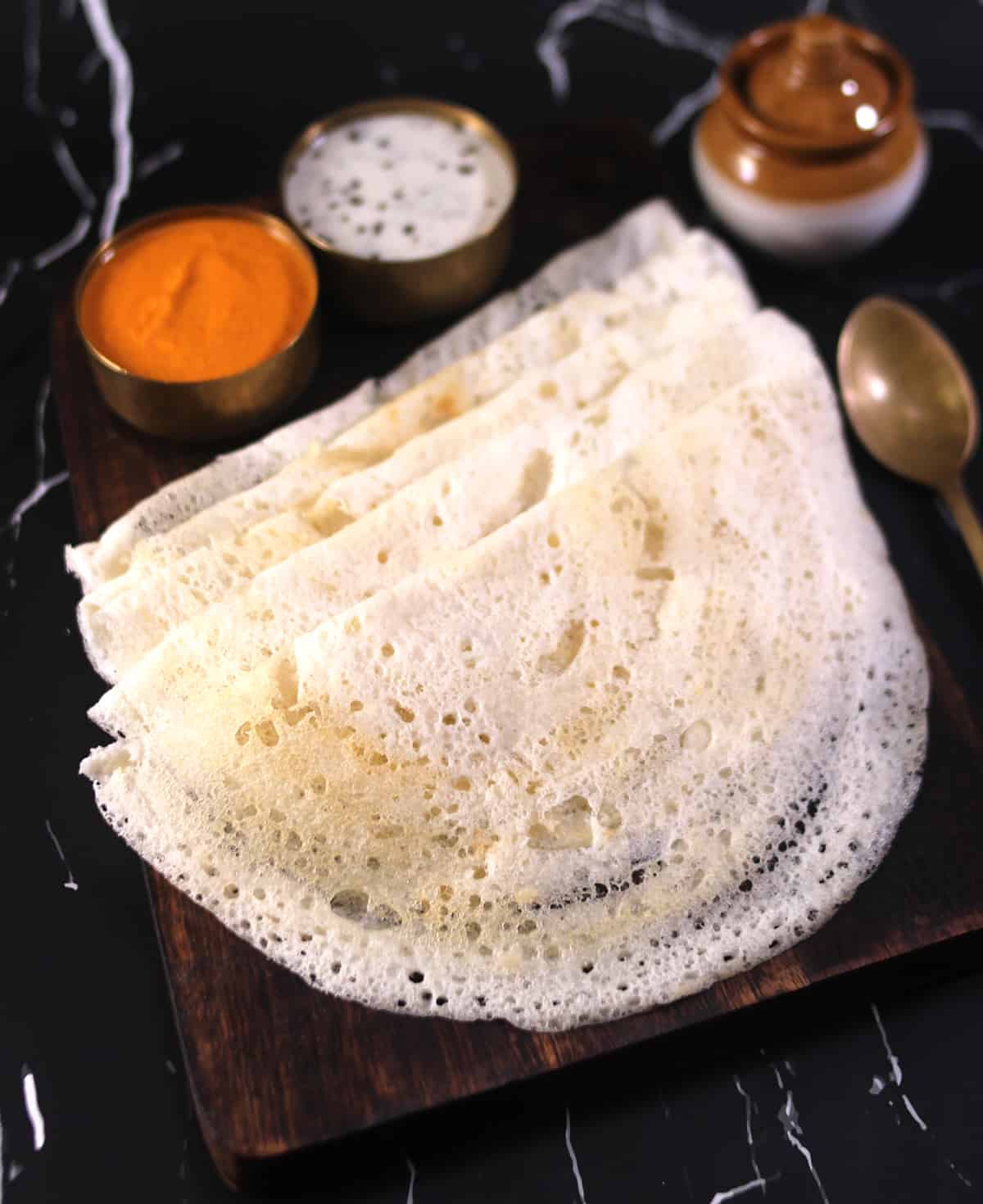
About Dosa and Dosa Batter
Dosa is an Indian crepe or pancake, a popular breakfast item made with fermented rice and lentil batter. Indian dosa (dosai, polo) is healthy, protein-packed, vegan, gluten-free, and dairy-free. Dosa is traditionally served with chutney and sambar.
What is different about this dosa batter recipe?
I have already shared recipes for 1 Dosa batter - 7 recipes and also simple dosa idli batter, and many of my readers have already tried and loved it.
But for me, I missed my ammas touch. Her udid tandla polo (rice lentil dosa) had a different flavor. So this time, I asked her to send me the two ingredients she uses with her measurements, and this is all that recipe is about. I followed her instructions to grind the batter, and voila; it tasted the way I wanted. Now we follow this easy dosa recipe when we miss mom's food to make plain or crispy dosa, appe (paniyaram), and uttapam.
This Indian dosa batter recipe uses only rice and urad dal; the ratio is a little different, and no fenugreek seeds (methi) or poha are used. The rice and urad dal are soaked and ground separately and mixed. It gives the dosa a unique taste and texture.
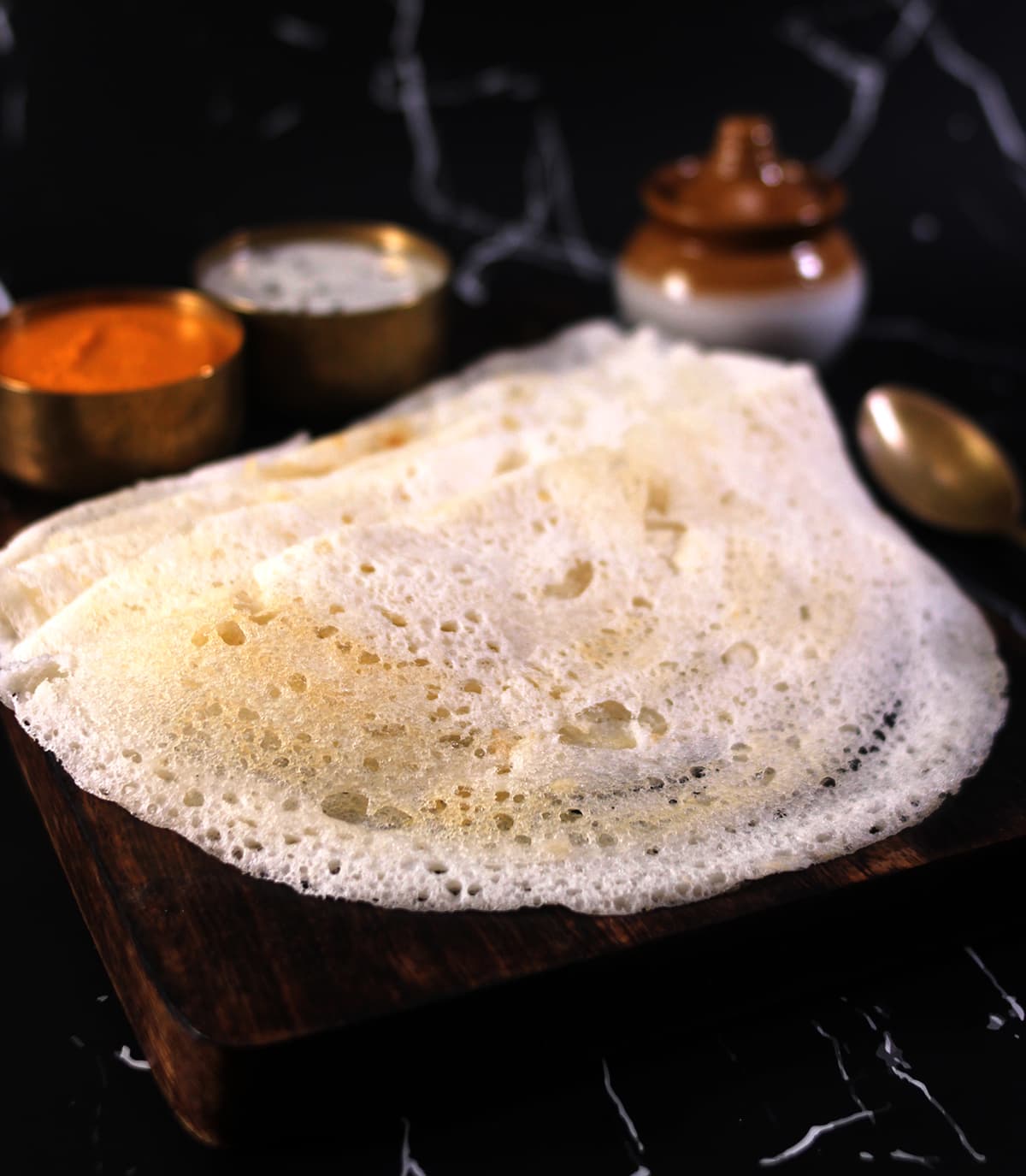
Mom's Tips
What I learned from my mom was to get the perfect and flavorful dosa
- Use premium urad dal (white in color).
- Use only dosa rice (All other rice will still work, but that flavor and texture will be missing).
- If you have a wet grinder, always make sure you grind atleast the urad dal in it than mixie. Because the way it becomes cloudy and fluffy cannot be replicated in mixie.
- For an authentic Mangalorean Konkani taste, cook dosa with coconut oil.
- For kids to enjoy the restaurant taste, cook with butter or ghee.
Wet Grinder vs. Mixer Grinder
When you use a mixie to make the batter, the machine gets heated up to above 100 degrees F. A wet grinder stays within 80 degrees F, which is ideal for dosa and idli batter fermentation, which results in soft and best dosas and idlis. The batter made in a wet grinder rises better even if you are in colder regions and gives consistent results.
Did you know the dosa batter made in the wet grinder won't turn sour quickly and can be stored in the refrigerator and used for up to 7 days, whereas the dosa batter made in a mixie grinder will turn sour and have to be used within 3 to 4 days.
Does that mean you should invest in a wet grinder? No. If you have a family like us who eat dosa and idli all seven days a week, it would be ideal. But you like to have it once or twice; then you can grind the dosa batter in the mixie itself.
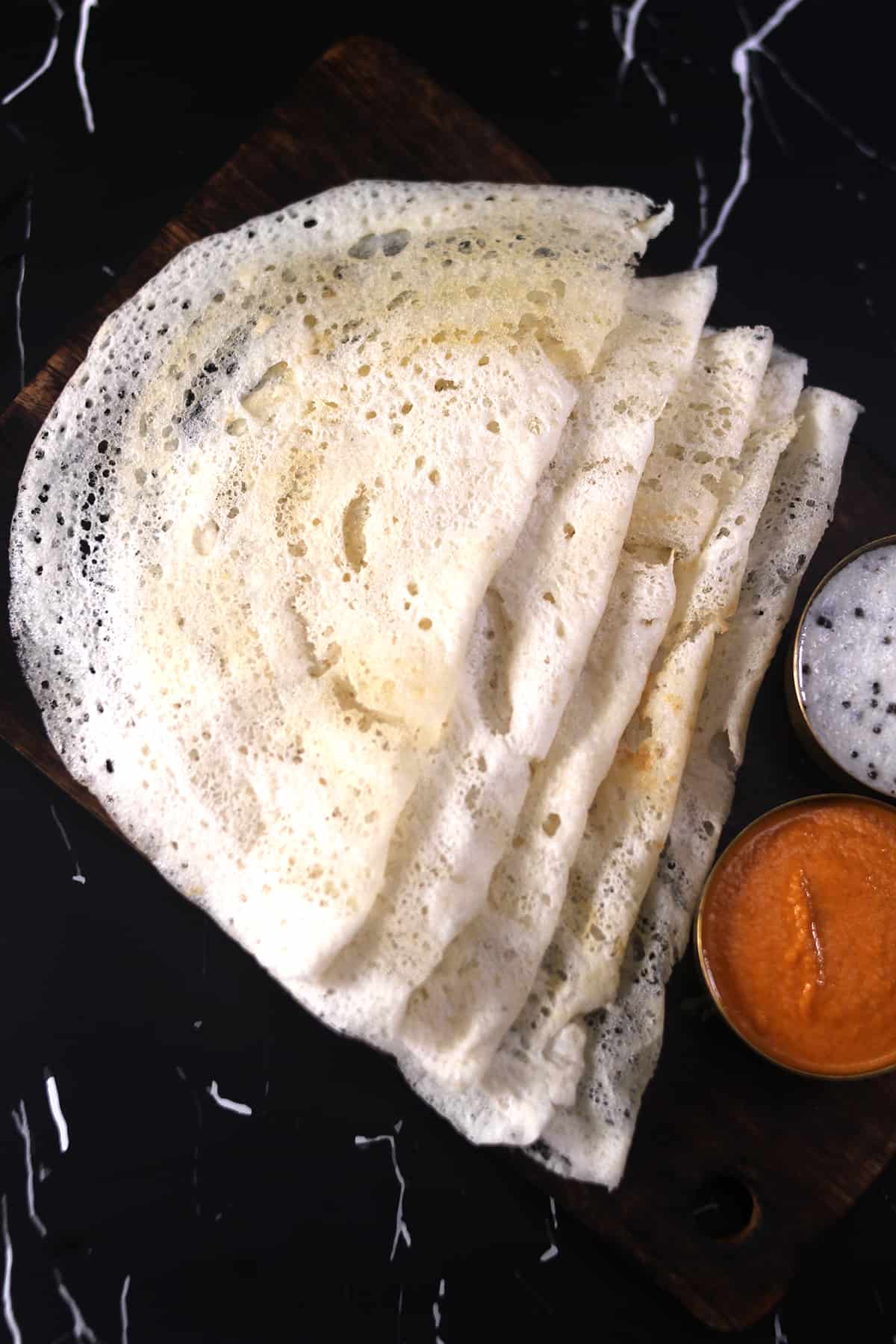
Follow these tips to make dosa batter in a mixie grinder to get the same results as that of a wet grinder.
- Grind urad dal and rice separately.
- For grinding, try to use ice-cold water. Never allow your mixie to get heated up.
- Use the premium urad dal. Quality of dal matters the most.
- Once the batter is mixed, mix well using clean hands. The microbes from your hand help in better fermentation. (For more information on dosa fermentation and tips, read our post on the complete dosa guide.)
- Once you make the batter and keep it for fermentation, do not stir until the batter is fermented completely.
Ingredients
Rice: Idli rice or dosa rice for best results.
Dal: Premium urad dal white in color (ulutham paruppu). You can get pictures and details of Indian dal here.
Other ingredients: Salt to taste and oil for cooking dosa.
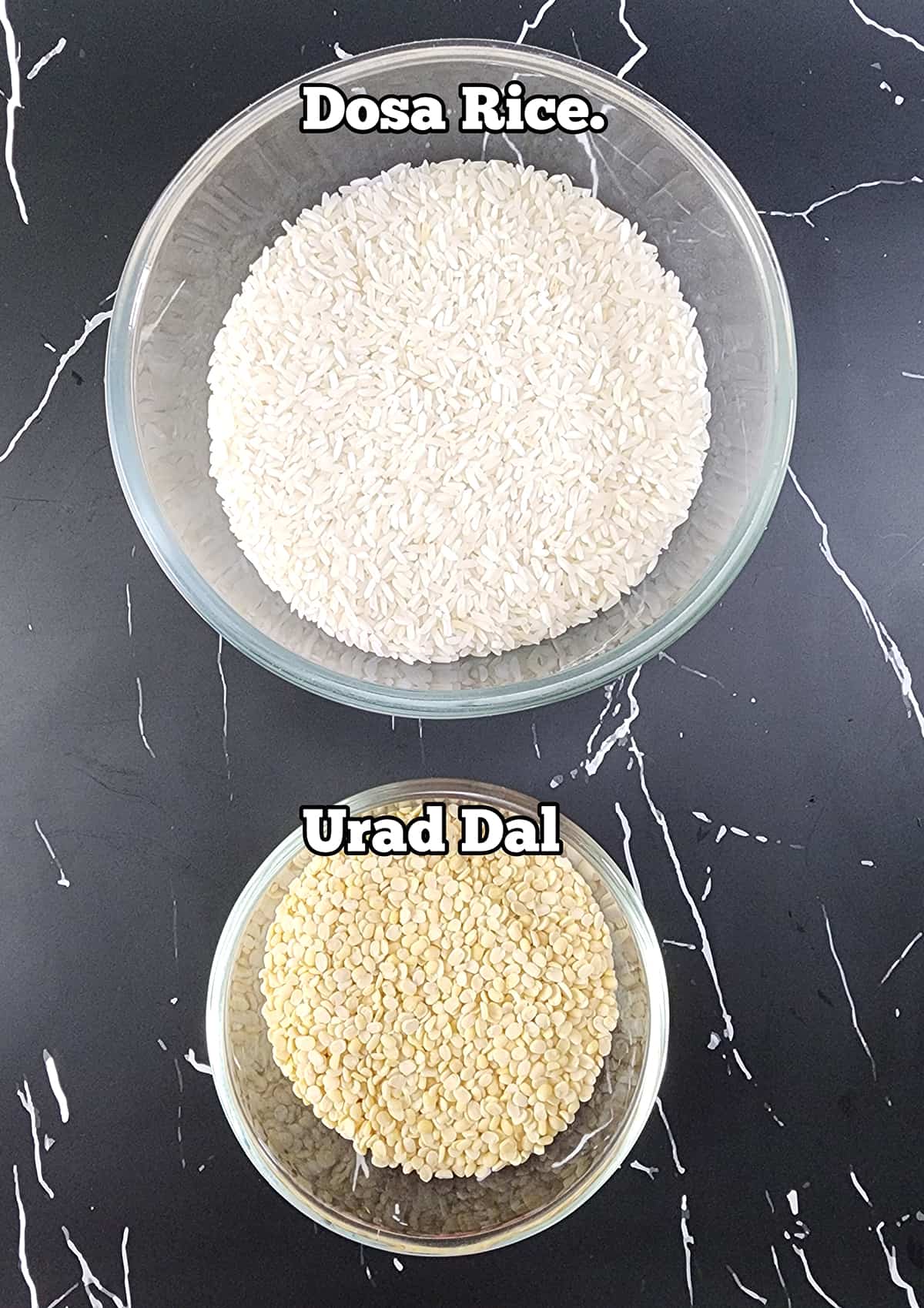
After multiple requests from readers, I have given dosa ingredients quantity in cups and grams.
See the recipe card below for a full list of ingredients and measurements.
Step-by-step instructions
How to make dosa batter?
Soak the dal and rice:
- Add urad dal in one bowl, wash it nicely in water a couple of times, and drain. Now soak it with fresh water and leave it for 4 to 6 hours.
- Similarly, in another bowl, add rice. Wash it nicely a couple of times and drain. Add fresh water and soak for 4 to 6 hours.
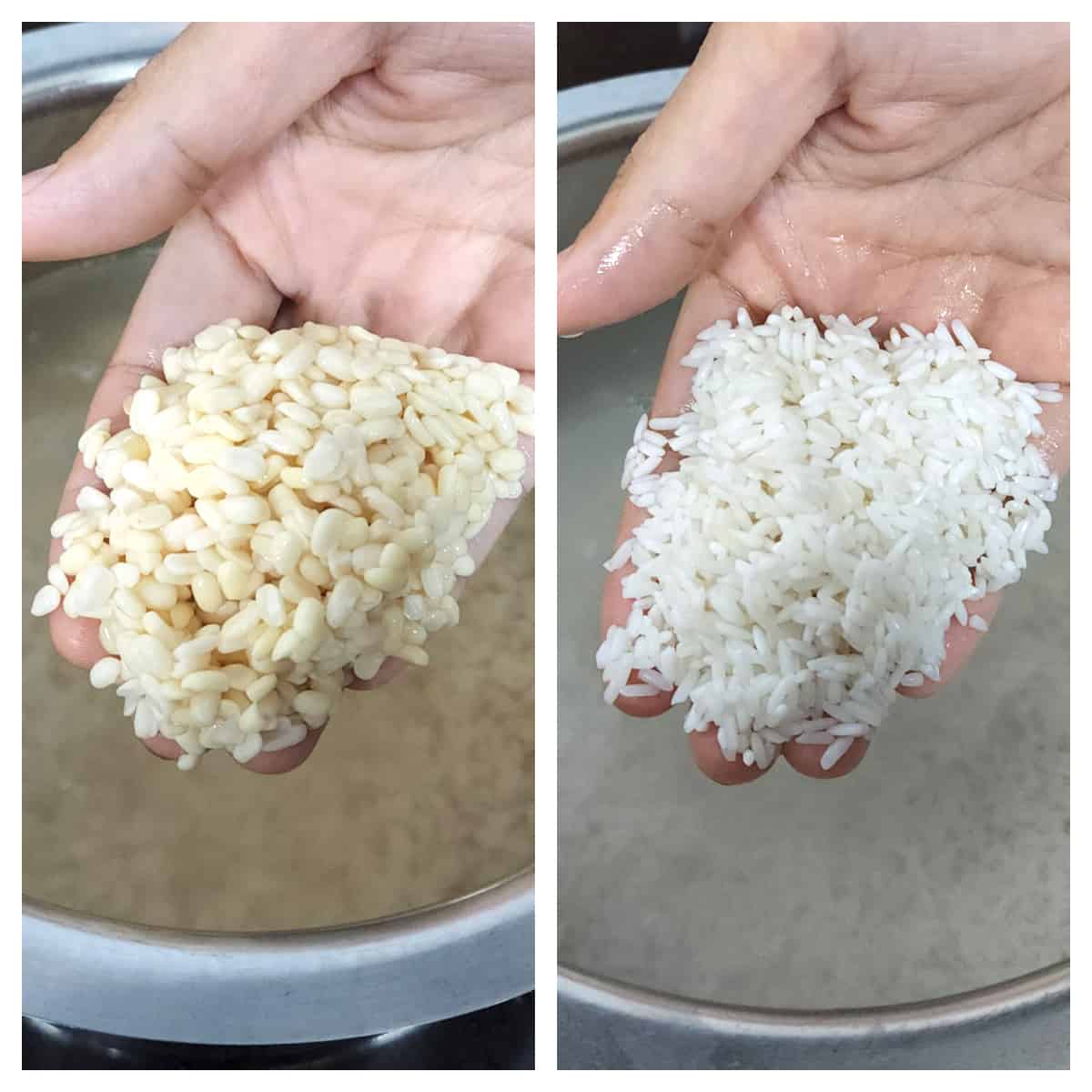
Grind the dal: Drain the water from the dal. Add the drained dal to the wet grinder or mixie jar with ½ cup water and grind to a thick, smooth paste. Add water in increments and grind. Transfer the ground urad dal to a large vessel or conatiner.
Grind the rice: Drain the water from the rice. Add rice with ½ cup of water to a wet grinder or mixie jar and blend it until it is smooth. Add water in increments as needed.
Transfer this ground rice to the ground urad dal and mix.
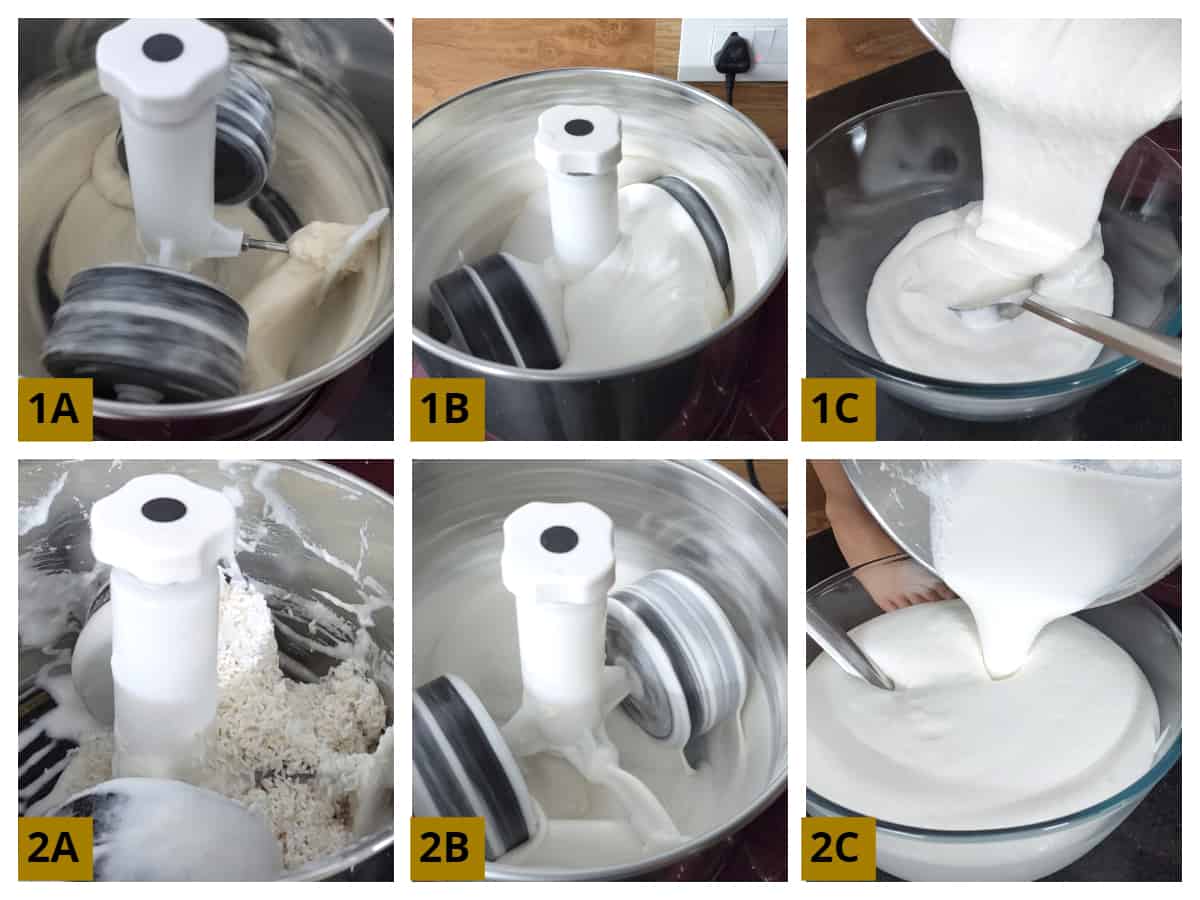
Pro Tips while grinding
- The amount of water you need for grinding in a wet grinder and mixie is different. The urad dal will become fluffy and airy in a wet grinder. In mixie, grind it till it becomes smooth.
- Ensure your batter does not warm while grinding both urad dal and rice. If your mixer or grinder gets heated up, turn it off, rest for a few minutes, and use ice-cold water for grinding. This will prevent dosas from becoming hard.
Dosa batter fermentation
If you want to ferment only a batch of batter, transfer it to one bowl and refrigerate the rest in another bowl. I generally do this, preventing the batter from turning sour quickly and having a longer shelf life.
Cover the vessel with a lid and let it ferment in a warm place. Dosa batter needs a minimum of 6 hours to ferment and may take up to 12 hours based on weather conditions.
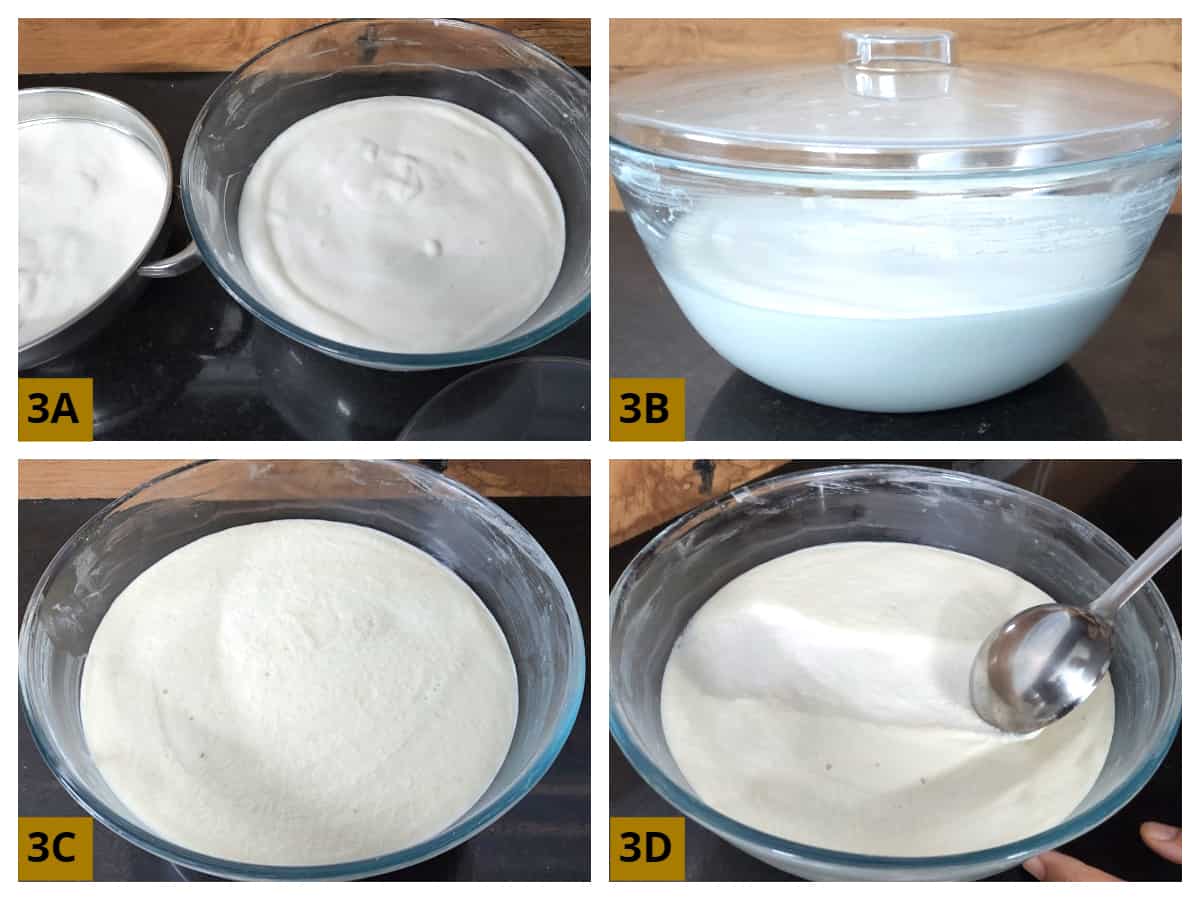
For warm weather conditions, Keep the batter on your kitchen counter overnight. The batter will ferment within 8 hours.
For cold weather conditions, Mix the batter with your hands so that the microbes help in fermentation. You can preheat the oven for 10 minutes and switch it off. Turn on the lights of the oven and keep the batter.
Instant pot fermentation of dosa batter: ferment the batter using the yogurt mode. Increase the time to 8 or 10 hours, and make sure you cover it with a glass lid and not with the Instant Pot lid, as this may lock if the batter ferments and overflows.
The fermented batter will increase in volume, foamy or bubbly on top.
Dosa Batter
The fermented batter is generally going to be thick. Add salt and a little water based on the consistency of the fermented batter and mix. Undisturbed batter, once fermented, can be stored for 5 to 6 days.
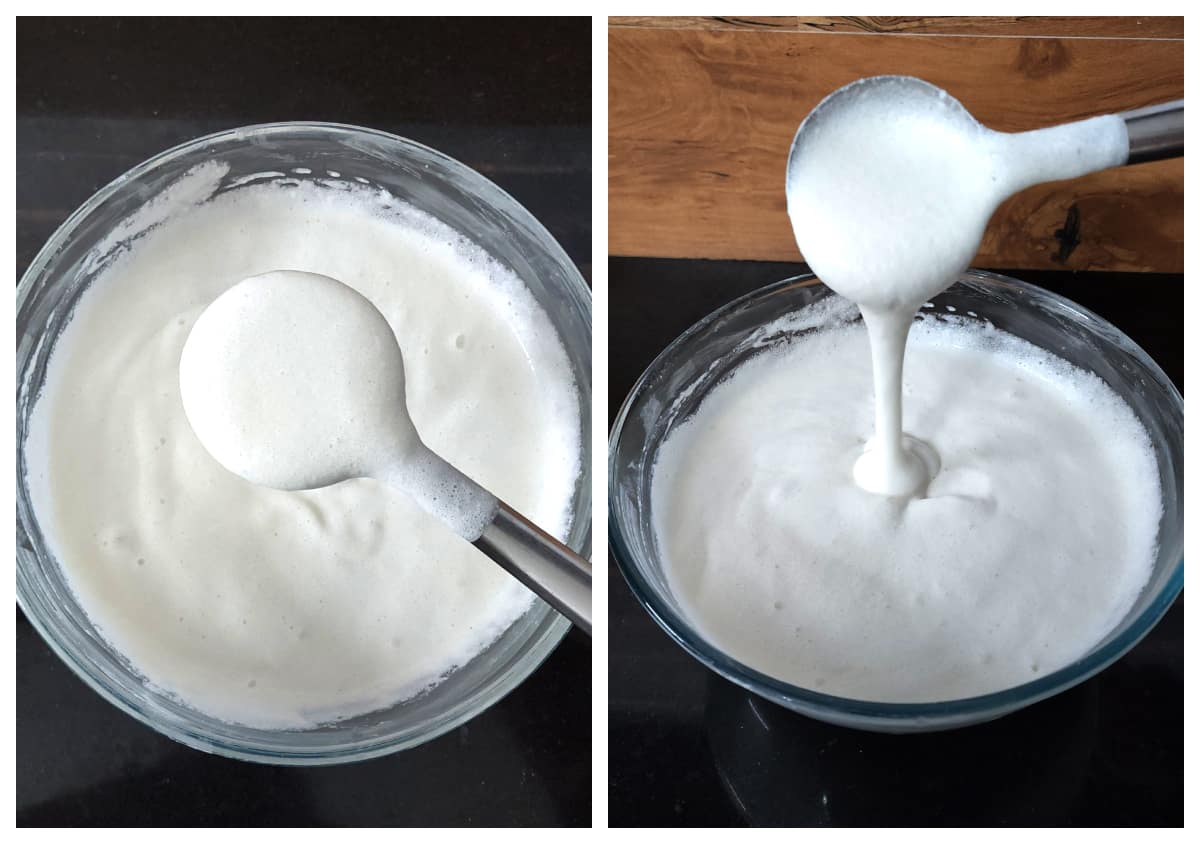
How to make dosa?
- Grease a cast iron skillet or non-stick pan with oil. Ensure no excess oil is left and it is absorbed completely.
- Heat dosa tawa on medium flame.
- Once hot, pour a ladle full of batter at the center and spread it in a circular motion. If you are not able to spread quickly, it means your batter is too thick. You may add a little extra water to the batter and mix.
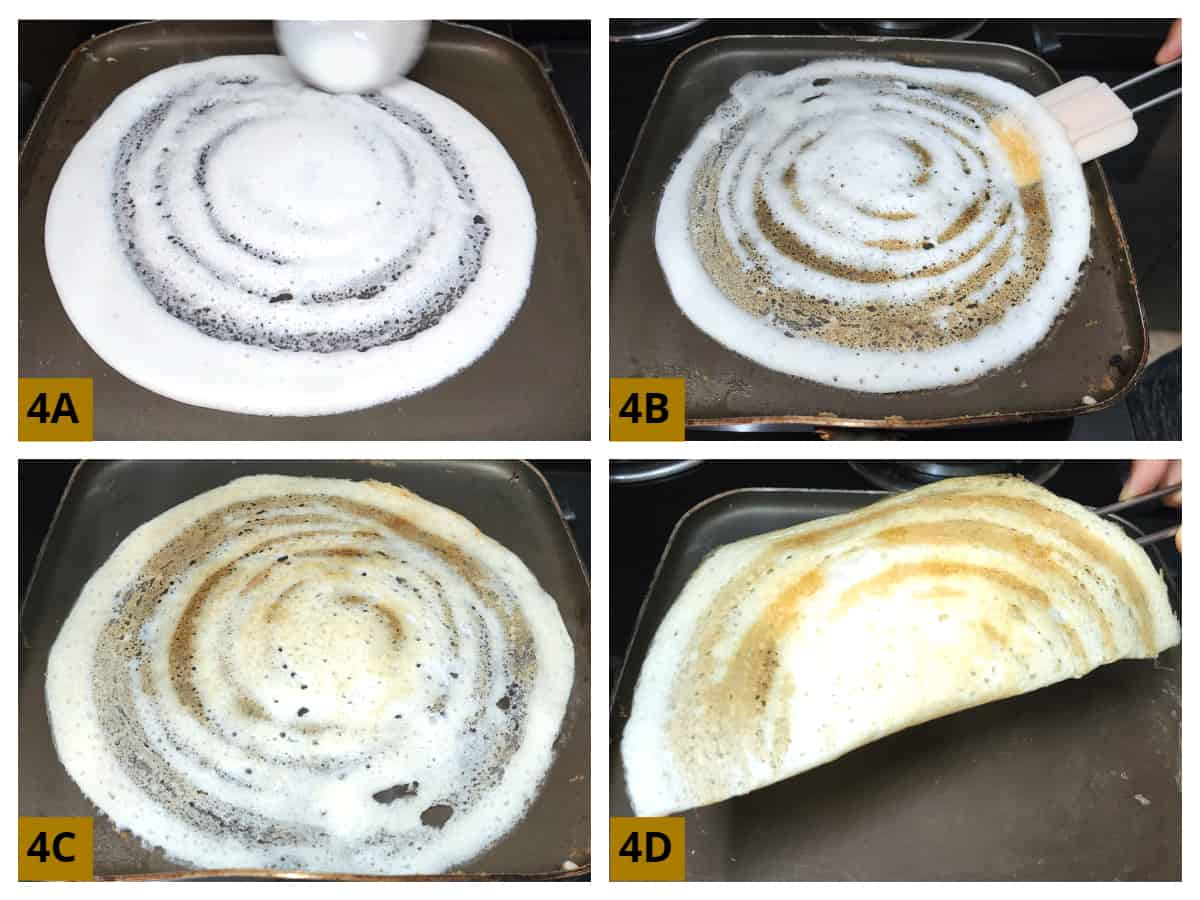
- Drizzle oil or ghee around the edges. In 2 to 3 minutes, the edges will start to come off, and the bottom of the dosa will start turning golden brown.
- Remove the dosa from the pan or flip and cook for another 1 minute if you like. Flipping is optional for this dosa.
- Before spreading the next dosa, you may grease the pan with oil or ghee and remove excess oil using a clean kitchen towel.
- Keep any leftover batter in the refrigerator.
You can learn how to make appe (paniyaram), plain crispy dosa, soft dosa, uttapam, masala dosa using the same batter here. (all in one dosa batter recipe).
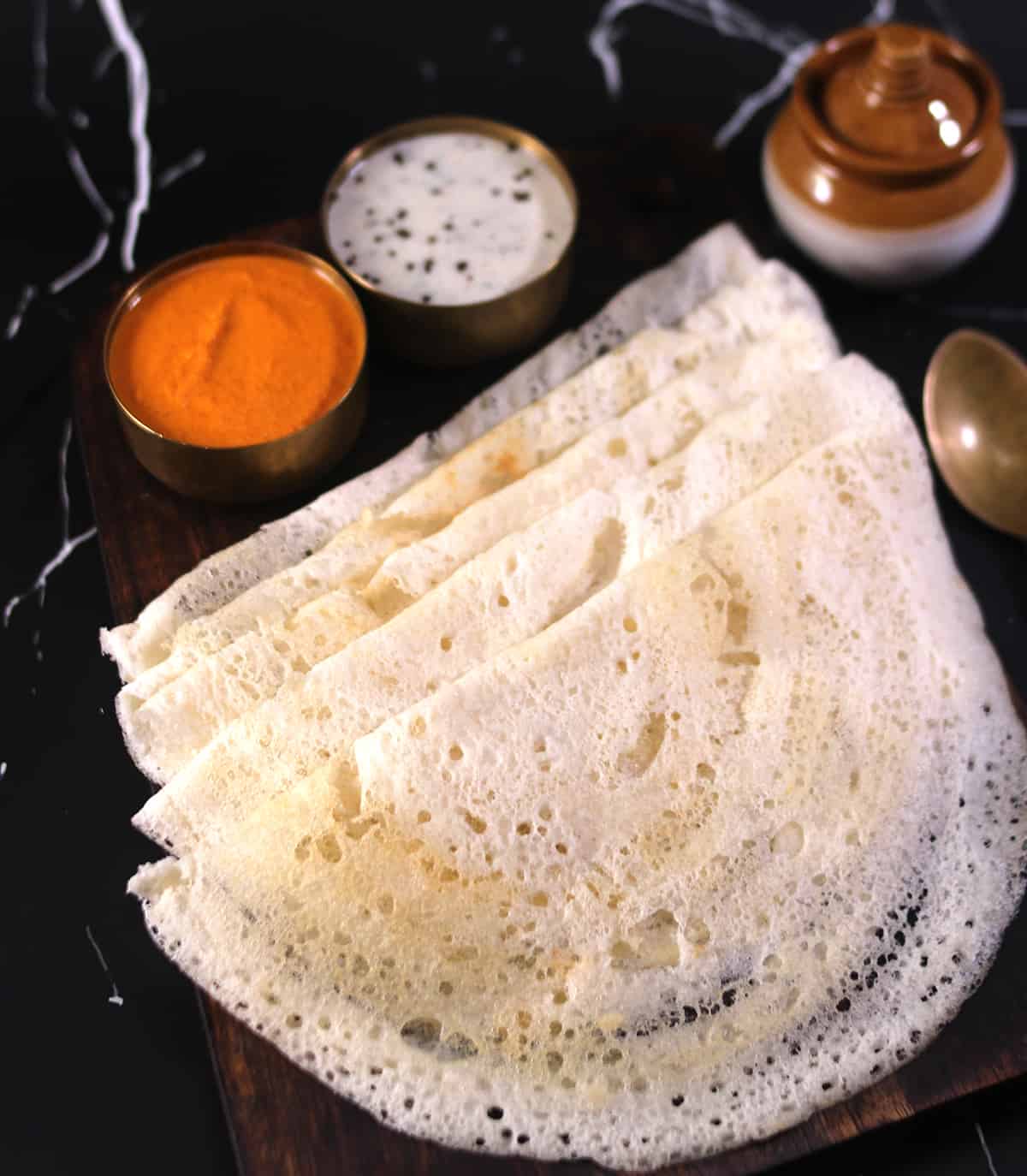
Pro Tips
- Use good quality dosa rice or idli rice and urad dal for best results.
- Proper fermenatation is very improtant. The time it takes to ferment may vary from 8 to 12 hours based on the climatic conditions. During summer in India, 6 hours is sufficient for dosa fermentation.
- The dosa batter should be of pouring consistency. If it is too thick, adjust by adding a little water.
- To avoid the dosa from sticking to the pan or laddle, make sure the batter is not over-fermented and the pan is not oily. If there is too much oil in a pan, wipe it off with tissue to avoid the batter from clumping when spreading.
- If you are making masala dosa, make sure you add the bhaji or potato filling only once the dosa turns golden in color, just before folding.
- I add salt to the batter only after fermentation.
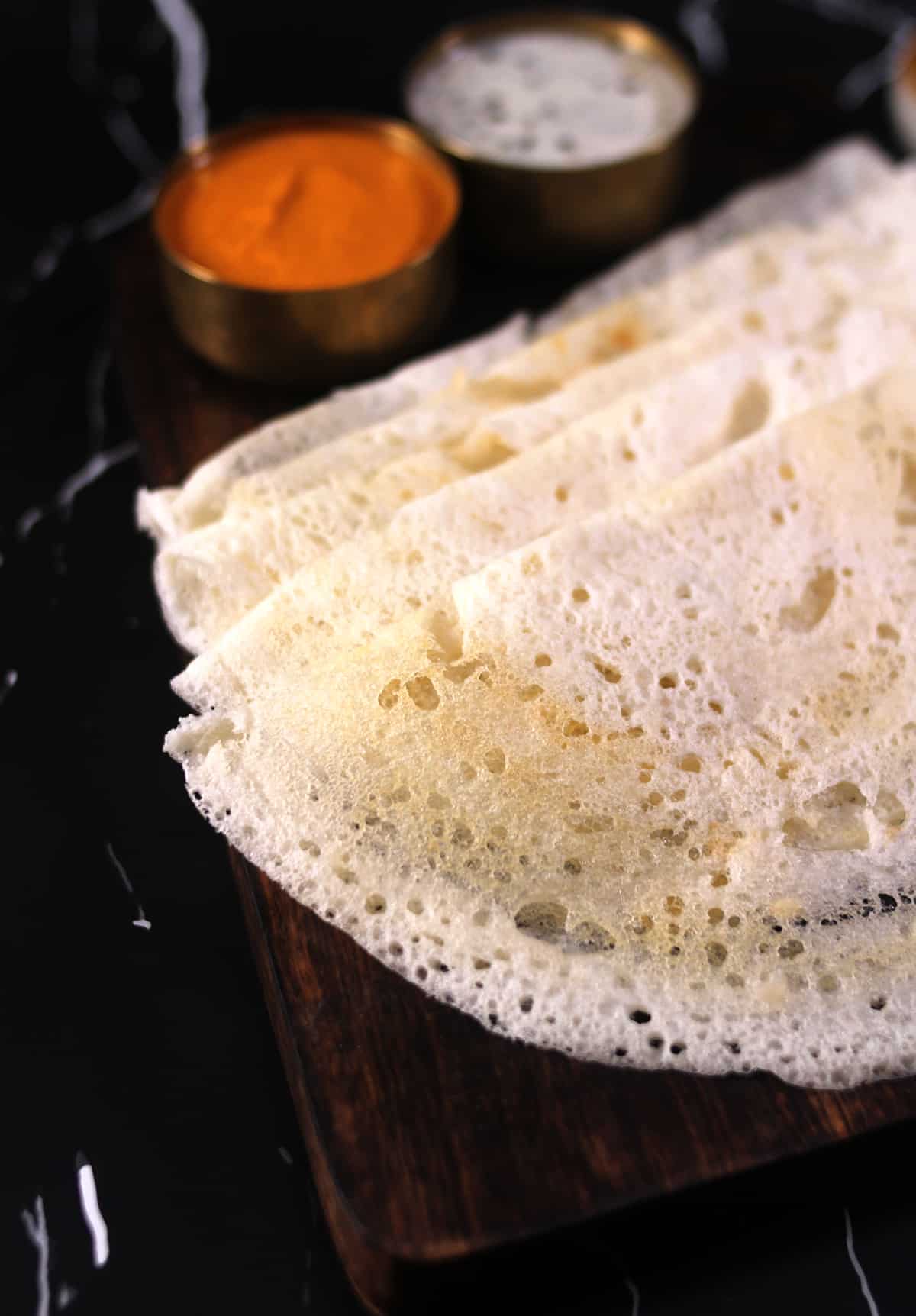
What to serve with dosa?
- Dosa and chutney, dosa and sambar are popularly served in combination at home and restaurants along with cup of Indian chai tea or filter coffee.
- Some chutney include traditional South Indian coconut chutney, tomato chutney, and mint chutney.
- Dosa and curry is another popular combo. Serve dosa with curry like vegetable stew, veg kurma, butter chicken, egg gravy, etc.
- This dosa recipe also called udid tandla dosa in konkani is also popularly offered with sweet moong dal khichdi in the form of naivedyam and served as prasad during dhanurmasam.
Recipe FAQs
For stress-free cooking, always use a non-stick pan to cook dosa. If you want authentic crispy dosa, then use a cast-iron skillet to cook the dosa.
Masala dosa is the best and most popular dosa, after which uttapam and neer dosa are the current trending dosa types. You can also make masala dosa and uttapam using the same Dosa batter mix. Just make sure you cook it with ghee or butter so that it becomes crisp and golden brown.
Dosa is a traditional breakfast recipe, but since it is healthy, inexpensive, easy to make, and rich in carbs and protein, you can serve it for any meal.
This dosa batter needs fermentation. There are some other dosa recipes that need no fermentation at all, like neer dosa, cucumber dosa, and rava dosa with pumpkin, zucchini, etc.
Yes. Make sure to thaw it overnight before using it.
More Indian Dosa Recipes
Did you like this recipe? Please leave a star ⭐️⭐️⭐️⭐️⭐️ rating below and/or a review in the comments section. You can also stay in touch with us through social media by following us on Pinterest, Facebook, Instagram, and Twitter.
Recipe card
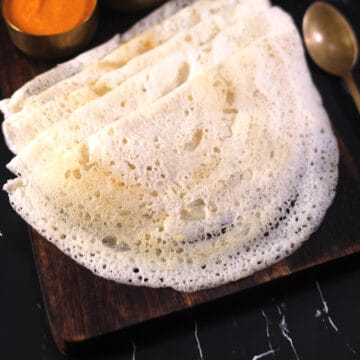
Indian Dosa | Mom's 2 Ingredient Dosa Batter Recipe
Equipment
- Dosa tawa
- Large pot or container
Ingredients
- 1 cup Urad dal 200 grams
- 2 ½ cups Dosa rice 520 grams
Other ingredients
- Water for grinding
- Salt to taste
- Coconut oil or vegetable oil for cooking dosas.
Instructions
How to make dosa batter?
- Soak the dal and rice: Add urad dal in one bowl, wash it nicely in water a couple of times, and drain. Now soak it with fresh water and leave it for 4 to 6 hours.1 cup Urad dal
- Similarly, in another bowl, add rice. Wash it nicely a couple of times and drain. Add fresh water and soak for 4 to 6 hours.2 ½ cups Dosa rice
- Grind the dal: Drain the water from the dal. Add the drained dal to the wet grinder or mixie jar with ½ cup water and grind to a thick, smooth paste. Add water in increments and grind. Transfer the ground urad dal to a large vessel or conatiner.Water
- Grind the rice: Drain the water from the rice. Add rice with ½ cup of water to a wet grinder or mixie jar and blend it until it is smooth. Add water in increments as needed.
- Transfer this ground rice to the ground urad dal and mix.
Pro Tips while grinding
- The amount of water you need for grinding in a wet grinder and mixie is different. The urad dal will become fluffy and airy in a wet grinder. In mixie, grind it till it becomes smooth. Ensure your batter does not warm while grinding both urad dal and rice. If your mixer or grinder gets heated up, turn it off, rest for a few minutes, and use ice-cold water for grinding. This will prevent dosas from becoming hard.
Dosa batter fermentation
- If you want to ferment only a batch of batter, transfer it to one bowl and refrigerate the rest in another bowl. I generally do this, preventing the batter from turning sour quickly and having a longer shelf life.
- Cover the vessel with a lid and let it ferment in a warm place. Dosa batter needs a minimum of 6 hours to ferment and may take up to 12 hours based on weather conditions.
- For warm weather conditions, Keep the batter on your kitchen counter overnight. The batter will ferment within 8 hours.
- For cold weather conditions, Mix the batter with your hands so that the microbes help in fermentation. You can preheat the oven for 10 minutes and switch it off. Turn on the lights of the oven and keep the batter.
- Instant pot fermentation of dosa batter: ferment the batter using the yogurt mode. Increase the time to 8 or 10 hours, and make sure you cover it with a glass lid and not with the Instant Pot lid, as this may lock if the batter ferments and overflows.
- The fermented batter will increase in volume, foamy or bubbly on top.
Dosa Batter
- The fermented batter is generally going to be thick. Add salt and a little water based on the consistency of the fermented batter and mix.Salt
- Undisturbed batter, once fermented, can be stored for 5 to 6 days.
How to make dosa?
- Grease a cast iron skillet or use a non-stick pan. Ensure no excess oil is left and it is absorbed completely.Coconut oil
- Heat dosa tawa on medium flame.
- Once hot, pour a ladle full of batter at the center and spread it in a circular motion. If you are not able to spread quickly, it means your batter is too thick. You may add a little extra water to the batter and mix.
- Drizzle oil or ghee around the edges. In 2 to 3 minutes, the edges will start to come off, and the bottom of the dosa will start turning golden brown.
- Remove the dosa from the pan or flip and cook for another 1 minute if you like. Flipping is optional for this dosa.
- Before spreading the next dosa, you may grease the pan with oil or ghee and remove excess oil using a clean kitchen towel.
- Keep any leftover batter in the refrigerator.
- You can learn how to make appe (paniyaram), plain crispy dosa, soft dosa, uttapam, masala dosa using the same batter here. (all in one dosa batter recipe).
Notes
- Use good quality dosa rice or idli rice and urad dal for best results.
- Proper fermenatation is very improtant. The time it takes to ferment may vary from 8 to 12 hours based on the climatic conditions. During summer in India, 6 hours is sufficient for dosa fermentation.
- The batter should be of pouring consistency. If it is too thick, adjust by adding a little water.
- To avoid the dosa from sticking to the pan or laddle, make sure the batter is not over-fermented and the pan is not oily. If there is too much oil in a pan, wipe it off with tissue to avoid the batter from clumping when spreading.
- If you are making masala dosa, make sure you add the bhaji or potato filling only once the dosa turns golden in color, just before folding.
- I add salt to the batter only after fermentation.

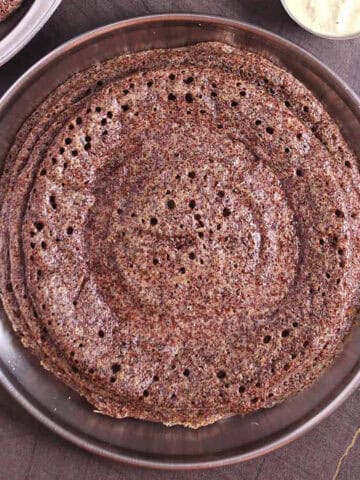
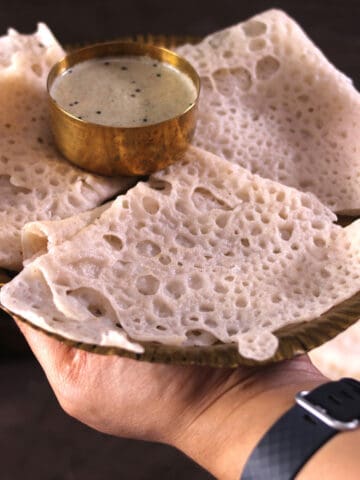
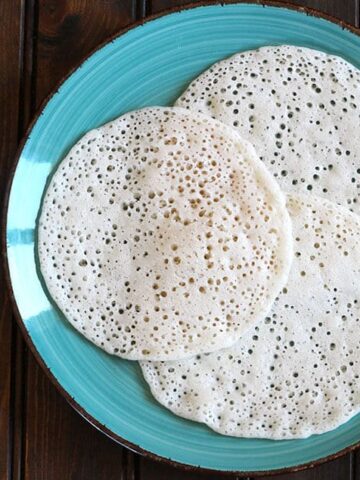
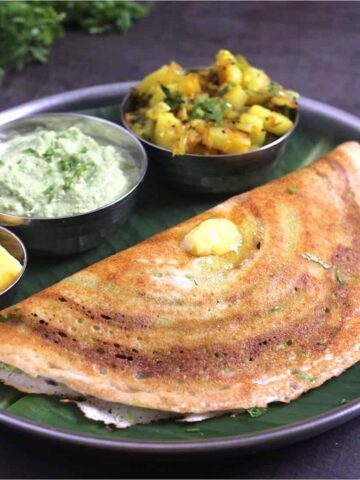
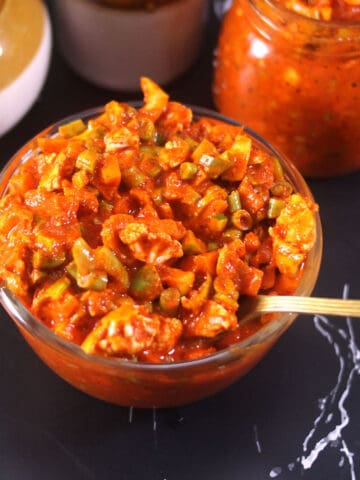
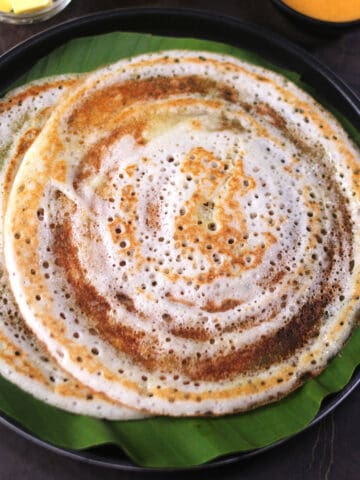
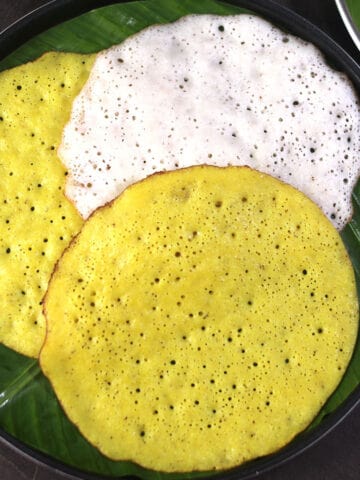
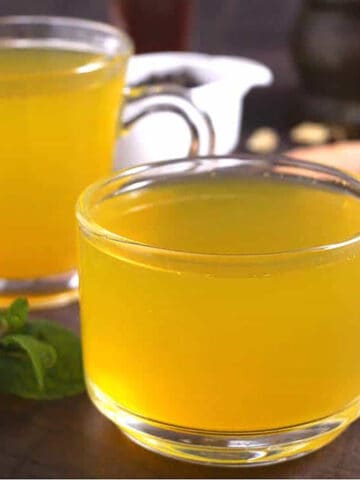
Comments
No Comments